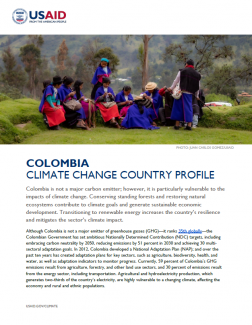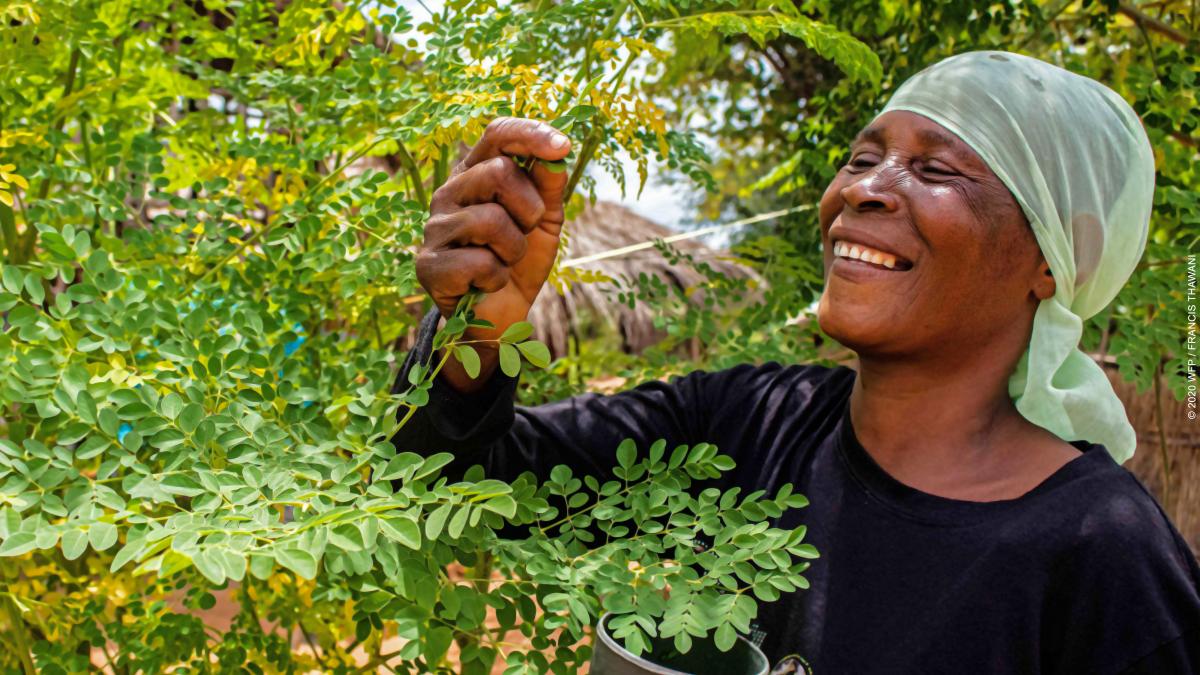Colombia is not a major carbon emitter; however, it is particularly vulnerable to the impacts of climate change. Conserving standing forests and restoring natural ecosystems contribute to climate goals and generate sustainable economic development. Transitioning to renewable energy increases the country’s resilience and mitigates the sector’s climate impact.
Although Colombia is not a major emitter of greenhouse gasses (GHG)—it ranks 35th globally—the Colombian Government has set ambitious Nationally Determined Contribution (NDC) targets, including embracing carbon neutrality by 2050, reducing emissions by 51 percent in 2030 and achieving 30 multi-sectoral adaptation goals. In 2012, Colombia developed a National Adaptation Plan (NAP); and over the past ten years has created adaptation plans for key sectors, such as agriculture, biodiversity, health, and water, as well as adaptation indicators to monitor progress. Currently, 59 percent of Colombia’s GHG emissions result from agriculture, forestry, and other land use sectors, and 30 percent of emissions result from the energy sector, including transportation. Agricultural and hydroelectricity production, which generates two-thirds of the country’s electricity, are highly vulnerable to a changing climate, affecting the economy and rural and ethnic populations.
Government of Colombia Climate Priorities
In November 2020, the Colombian Government announced ambitious GHG emission cuts and other commitments to increase climate resilience as part of Colombia's updated NDC. These climate mitigation and adaptation targets included:
- A ten-year strategy to invest USD $200 million to reach zero net deforestation by 2030.
- An energy transition plan to include: 1) solar, wind, biomass, and small hydro projects; 2) the development of sustainable mobility solutions; 3) the launch of new technologies such as green hydrogen and geothermal; and 4) the adoption of a carbon-neutral policy for the sector.
- An enhanced Colombian carbon market and establishment of a Cap and Trade Emissions Trading Scheme. Since 2017, Colombia's carbon tax offset mechanism has traded 95 million tons of verified emissions reductions.
- The inclusion of climate change risks and innovative adaptation actions in priority economic sectors, such as transport, energy, agriculture, housing, health, commerce, tourism, and industry.
In August 2022, a new Colombian administration, led by President Gustavo Petro, restated that climate change policy will continue to be among Colombia’s top priorities. The main strategies the government is currently advancing include:
- Fighting deforestation in 28 deforestation hotspots in the Amazon through participatory approaches that includes communities, with strategies that address illegal activities, strengthen the capacity of the justice sector and local institutions, and exercise territorial control.
- Accelerating forest restoration to achieve at least 750,000 hectares, while decreasing deforestation rates.
- Creating a Climate and Biodiversity Fund to consolidate funding sources, catalyze new sustainable financing mechanisms, and improve transparency and accountability.
- Improving carbon market regulation to ensure additionality, transparency, participation and just prices.
- Accelerating NDC implementation and elevating climate adaptation, particularly water management.
- Continuing with the national transition to renewable energy, promoting international investments to harness Colombia’s wind and solar resources, and focusing on “democratization” of the energy sector, largely defined as universal and affordable access.
- Accelerating the transition to electric mobility in public transport as a major emissions reduction strategy.
USAID’s Climate Change Program: Objectives and Results
USAID supports Colombia’s development and climate priorities through a series of programs and partnerships across its climate adaptation, renewable energy, and natural climate solutions activities. USAID promotes integrated approaches to reduce emissions and build resilience to climate change into our rural economic development programs and will initiate new partnerships with the private sector and civil society to help Colombia achieve its ambitious GHG emission reduction targets.
Adaptation
USAID supports improved environmental management of Colombia’s most threatened ecosystems, including the Orinoquia flooded savannas, Caribbean dry forests, Andean paramos, and the Amazon and Pacific coast tropical forests. USAID is improving Colombia’s climate resilience through increased access to information to reduce climate-related risks, promotion of climate smart agricultural practices, and support for ecosystem conservation and restoration, and by expanding vegetative cover to protect soil and conserve water.
Results
- Strengthened climate resilience through nature-based solutions by improving the natural resource management of 200,000 hectares in the Amazon region. A total of 20,910 people were trained on sustainable natural resource management, of whom 42 percent were women.
- Increased economic incentives for conservation, such as payment for ecosystem services to protect more than 29,000 hectares and commercial agreements for agricultural products. Provided over 70,450 people with greater economic benefits and improved the conservation of key watersheds and other ecosystems.
- Protected water sources and biological corridors through the establishment of forage banks to prevent soil degradation and improve livestock nutrition in 140,000 hectares dedicated to dairy and beef production.
Key Adaptation Programs
Paramos and Forests works with rural and indigenous communities to protect and restore native tropical forests, watersheds, paramos, and high-mountain ecosystems, reducing the vulnerability of downstream communities to the impacts of climate change, while conserving the soils and peatland carbon sinks.
Productive Nature champions partnerships between the private sector and local communities to drive substantial progress in biodiversity conservation and preserve nature’s services to sustain and improve livelihoods and enhance climate change resilience. Through a market systems strategy, the Activity seeks to favorably influence enterprises’ business models, including local entrepreneurships, through implementation of Nature-based Solutions (NbS), within value chains from sectors such as agriculture, cosmetics, and energy. Implementation of NbS improves management, protection, and restoration of ecosystems, safeguarding the provision of environmental services for livelihoods and improving local communities’ resilience to climate change. The Activity also uses a landscape approach to work on three socio-ecological corridors, located in the Andean, Caribbean, and Orinoquía regions of Colombia, to conserve biologically significant ecosystems including tropical dry forests, peatlands, wetlands, and flooded savannas.
SERVIR-Amazonia promotes collaboration among governments, universities, non-governmental organizations, community groups, and U.S. scientists. The ultimate goal is to improve local capacity to harness satellite data and geospatial information to foster sustainable natural resource management throughout the Amazon. In Colombia, SERVIR empowers local actors, including indigenous communities, to track environmental changes in near real-time, evaluate climatic threats, monitor land-based greenhouse gas emissions, improve the management of protected areas and other conservation areas, and forecast wildfires, floods, and extreme weather events. The Comprehensive Action for Climate Change Initiative (CACCI) assists the Government of Colombia in accelerating the implementation of the country's targets under the Paris Agreement. CACCI supports the coordination and monitoring of the NDC Implementation Plan and generates inputs to update this contribution in 2025 and to construct a new NDC for 2050. CACCI focuses on the identification of adaptation initiatives in national, territorial, and private sector entities, to articulate them with existing instruments, strategies, and planning tools.
Renewable Energy
USAID promotes the transition to low-cost, renewable energy in the Colombian market through planning, integration, and operational support. USAID is supporting market-based policies to develop Colombia's wind and solar potential, which is fundamental in reducing vulnerability to increasing El Niño droughts that reduce hydro generation, increase dependence on coal and gas generation, and raise the price of energy to the economy and society. This work also focuses on rural and conflict-affected areas, increasing access to renewable energy with a focus on elevating productivity, incomes, and well-being. USAID fosters new economic opportunities through a capacity building program for young leaders of the energy sector; a renewable energy job training program for indigenous communities; the transfer of U.S. expertise to craft policy and regulatory frameworks geared to deploying solar and wind resources and incentivizing emissions reductions in the energy sectors.
Results
- Helped the Colombian Government implement its renewable energy auction program, resulting in the award of 15-year power purchase agreements to 22 new solar and wind projects. These projects will increase renewable energy generation by 2,100 megawatts, leverage USD $2 billion in private sector investment between 2023-2026, and create approximately 44,000 new jobs.
- Assisted Colombia’s new competitive renewable energy procurement process leading to historically low average energy prices of USD $28 per megawatt hour (MWh).
- Provided strategic renewable energy training to 65 young energy sector professionals, 68 percent of whom were women, to further Colombia’s ability to manage its growing renewable energy supply into the national grid.
- Facilitated strategic renewable energy training to 37 young leaders from Wayuu Indigenous communities in La Guajira. This training has prepared young leaders to effectively participate in the growing renewable energy job market, through the creation of viable project proposals to support their development needs, and representation of their communities in community consultations related to new renewable energy projects targeted for their territories.
- Supported Providencia Island’s natural disaster recovery efforts and advancing its renewable energy transition through the creation of the Providencia Island Renewable Energy Master Plan, and provision of essential equipment to establish the island’s new solar power plant for Providencia’s Raizal Indigenous Community.
Key Renewable Energy Programs
Energy for Peace supports the planning, building, and operation of mini solar energy grids to support the growth of productivity clusters in priority conflict-affected communities with no energy access. The energy grids will enable communities to access affordable, clean energy needed to increase productivity, improve well-being, and foster social stability. This program seeks to leverage private sector investment in rural energy communities through the use of innovative blended finance mechanisms, designed with USAID’s INVEST mechanism.
The U.S. National Renewable Energy Laboratories (NREL) Partnership provides policy, planning, modeling, and deployment support to national energy entities within the Colombian Government to deliver clean, reliable, and affordable power.
The U.S. Energy Association Partnership (USEA) provides U.S. energy industry expertise to assist Colombian Government institutions and utility companies improve the electricity system’s reliability and growth. USEA also strengthens energy utility employees’ capacities to manage power systems, develop renewable energy resources and design off-grid power sources.
The Scaling Up Renewable Energy Program (SURE) focuses its technical assistance to support the Colombian Government’s ambitious program to transition to renewable energy, mitigate energy sector emissions and position indigenous and Afro-Colombian communities to better participate in the burgeoning renewable energy economy.
Natural Climate Solutions
USAID promotes reducing deforestation and forest degradation through sustainable forestry and agricultural, and community land management in order to address the causes of land use change, promote sustainable livelihoods, and increase the effectiveness of environmental policies. Protecting forests and other key ecosystems sustains livelihoods, mitigates climate change risks, and maintains environmental services like biodiversity conservation, carbon capture, and water purification.
Results
- Worked with 18 Afro-Colombian communities and one indigenous community to develop and implement eight reduced emissions from deforestation and forest degradation (REDD+) projects protecting 500,000 hectares of Pacific forests.
- Generated and sold 6.1 million Verified Carbon Units (VCUs) in the carbon market valued at USD $27.9 million to date. Completed the second carbon verification, expected to generate approximately 4.2 million additional VCUs.
- Studied the pre-feasibility of five REDD+ Projects in conflict-affected areas with the potential of generating five million annual carbon credits, protecting 1,080,000 hectares. Ethnic and farmer communities engaged in two REDD+ projects, reached agreements with private and NGO actors to develop and implement the projects.
- Developed the first protocol and supporting tools to monitor GHG in paramos ecosystems and include paramo GHG accountability in Colombia's GHG Report and NDC.
- Promoted and strengthened conservation enterprises within the amazon region, generating livelihood co-benefits (monetary or non-monetary) to over 1,500 people.
- Avoided the emission of 550,000 CO2 eq tons agroforestry and conservation interventions in productive farms.
- Developed the first free access financed emissions accounting tool in Latin America.
Key Natural Climate Solutions Programs
Paramos and Forests helps the Colombian Government meet its landscape-based climate change mitigation goals and strengthens local economic development. It does this through reduced emissions from deforestation and forest degradation (REDD+), and improved local actors’ capacities to measure, report, and verify emissions.
Colombia Forests and Wetlands promotes the transfer of forest and natural resources management expertise from the U.S. Forest Service to local governments and communities, including technical assistance to increase public forest governance, wildfire management, and carbon monitoring to conserve biodiversity and reduce carbon emissions. The activity also supports the SilvaCarbon and Sustainable Wetlands Adaptation and Mitigation Program (SWAMP) to monitor and report carbon, and it strengthens Colombia’s capacity to incorporate carbon data into land policy, management, and strategy development processes.
Amazon Alive strengthens the capacity of national and local institutions to reduce deforestation, support biodiversity conservation, as well as promote legal economic alternatives that allow the inhabitants of the Amazon to live in harmony with the forest and promote its protection. This activity contributes to the reduction of GHG emissions as well as builds the climate resilience in Colombia.
Land for Prosperity implements Colombia's multipurpose cadaster and awards land-use rights in areas previously designated as forest reserves in the Amazon as an incentive to promote sustainable economic practices to reduce a key driver of deforestation.
Destination Natureconserves biodiversity and reduces greenhouse gas emissions by supporting rural communities to make a living from sustainable nature tourism. With a focus on regenerative nature tourism, the Activity works with local communities to build business models that have a positive impact on sustainable land use, reducing ecosystem degradation and protecting biodiversity. The Activity uses a landscape approach to work on fourteen nature tourism corridors in six regions in Colombia that have strong nature tourism potential and face significant environmental threats. The work focuses on improving nature tourism governance, enhancing business, social and environmental performance of tourism destinations, and promoting sustainable land practices at scale.
The Sustainable Agriculture Activity supports both adaptation and mitigation co-benefits through the expansion of licit, profitable, and climate-smart agricultural (CSA) business models. SAA encourages producers to adopt CSA models, like agroforestry and silvopastoral models. The use of CSA by producers supports conservation, reduces emissions from land use change, increases carbon sequestration, and increases the adaptive capacity of its beneficiaries. To accurately measure and predict emissions reductions, Sustainable Agriculture partnered with Alliance Biodiversity International - CIAT to develop an emissions measurement methodology at the farm and business level. This tool will be shared with the Government of Colombia for other projects to measure emissions reductions across the agricultural sector.
Tierra Dorada aims to reduce greenhouse gas emissions, promote biodiversity conservation, and support legal livelihoods in regions of Colombia where the expansion of artisanal and small-scale mining (ASM) has degraded ecosystems, diminishing their function as carbon reserves and habitat for numerous species of fauna and flora in the second most biodiverse country in the world. Tierra Dorada builds capacity of artisanal and small-scale miners increasing legality, and social and environmental responsibility. The Activity promotes initiatives to reduce deforestation, reduced emissions from ASM operations, and supports reclamation and rehabilitation of land degraded by mining. Tierra Dorada also supports alternative economic opportunities within mining communities, fostering legal markets, social inclusion, and environmental stewardship.
Sustainable Banking Alliance partners with the banking sector to accelerate the implementation of their roadmap to net-zero by developing a free-access emissions accounting tool and providing a capacity-building program for banks to expand their green portfolio and systematically measure and report climate metrics.
For More Information




